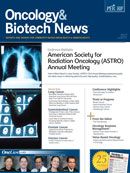Publication
Article
Oncology & Biotech News
Room for Improvement: Reporting Near-Misses and Errors in Radiation Oncology
Author(s):
A new study presented at the 2011 annual meeting of the American Society for Radiation Oncology (ASTRO) found that 97% of radiation oncology team members believe they have a responsibility to report near-misses and errors...

Eric C. Ford, PhD with colleague.
Radiation errors and their potential to harm patients were publicized in a front-page story in The New York Times in 2010, raising concerns about radiation safety. A new study presented at the 2011 annual meeting of the American Society for Radiation Oncology (ASTRO) found that 97% of radiation oncology team members believe they have a responsibility to report near-misses and errors, and up to 33% reported having been involved with or aware of a minor event but not reporting it to voluntary in-house systems designed to capture them. This reporting gap between observed and reported events was seen among all members of the clinic.
The study was based on an anonymous survey of 4 academic radiation oncology practices with sophisticated in-house reporting systems: Johns Hopkins Medical Center, Baltimore, Maryland; North Shore-Long Island Jewish Health System, New Hyde Park, New York; Washington University School of Medicine, St. Louis, Missouri; and University of Miami, Florida. Response rate to the survey was high, with 274 (81%) of all radiation staff participating, including attending physicians, residents, radiation therapists, nurses, dosimetrists, and physicists.
“Although strict rules govern the appropriate reporting of serious radiation events, there are no mandates regarding the reporting of lesser events or near-events, and no recommendations regarding the monitoring of these events for system-based improvements. Some institutions have proactively developed voluntary in-house reporting systems to better capture these events to improve patient safety,” said Kendra M. Harris, MD, a fourth-year radiation oncology resident at the Johns Hopkins Medical Institute.
“
Even in departments with sophisticated reporting systems, all radiation oncology team members admit there is a 'reporting gap.' ”
—Kendra M. Harris, MD
“Even in departments with sophisticated reporting systems, all radiation oncology team members admit there is a ‘reporting gap’,” Harris noted. Respondents to the survey acknowledged that reporting is their responsibility, that they are not too busy to do so, and that they know what to report, she said. However, she said, “Embarrassment is a critical barrier to reporting.”
Regarding barriers to reporting errors, the respondents said that concern about professional sanctions was prominent. “Embarrassment” was cited by 49% of attending physicians and 58% of resident physicians, while “getting my colleagues in trouble” was cited by 41% and 54% of physicians, respectively. “Admitting liability” was a close third, with 41% of attending physicians and 42% of residents citing that as a barrier to reporting errors. Forty percent of nurses and 47% of radiation therapists cited “getting my colleagues in trouble” as a barrier.
Communication failures were a common source of error, including set-up errors, complex stereotactic treatments, and computer-related events. Improving communication could address the problem, Harris said. “We may need help knowing how to report. Broad support exists for a national reporting effort,” she said.
A separate study, funded by the American Association of Physicists in Medicine (AAPM) and led by researchers from Johns Hopkins and the University of Calgary, focused on the development of a methodology for reporting, analyzing, and learning from incidents in radiotherapy. ASTRO and AAPM are working on recommendations that should facilitate the design and implementation of systems and promote interconnectivity, said Eric C. Ford, PhD, assistant professor in the Department of Radiation Oncology and Molecular Radiation Services at Johns Hopkins University. Expected to be released by the end of this year, these recommendations in 5 areas will be made by the ASTRO and AAPM Working Group on Prevention Errors:
• Definitions—a glossary of 47 common terms for incident reporting specific to radiation oncology;
• Process Maps showing essential steps for reporting errors;
• Severity Metrics—2 scales, one for potential medical severity and one for dosimetric deviation from prescription;
• Causal Taxonomies—a table to guide identification of root factors and contributory factors of an incident;
• Data Elements required for a reporting system.






























%20(2)%201-Recovered-Recovered-Recovered-Recovered-Recovered-Recovered-Recovered-Recovered-Recovered-Recovered-Recovered-Recovered-Recovered-Recovered-Recovered-Recovered-Recovered.jpg?fit=crop&auto=format)
%20(2)%201-Recovered-Recovered-Recovered-Recovered-Recovered-Recovered-Recovered-Recovered-Recovered-Recovered-Recovered-Recovered-Recovered-Recovered-Recovered-Recovered-Recovered.jpg?fit=crop&auto=format)